As is probably the case for many hobbyists, my hobbies have been solitary pursuits. From the time I first started building plastic scale models in 1955, my work has all been my own; I never had any supervision or mentors. And, until the Eighties, when I joined Austin Model Cars, and 2010, when I joined Austin Slot Car Club, I never had any friends with whom to share my hobbies.
My first slot track was an Aurora Model Motoring HO track with the original “vibrator cars” in 1961. Every time I ran it, my father complained because the A/C current that the cars ran on caused intense static on our TV.
Then, in 1962, I put an AMT Turnpike set in layaway at the local hobby store and finished paying it off by Christmas. The Authentic Model Turnpike was an extremely ambitious project designed to adapt AMT’s line of 1/25th scale annual promotional cars and kits to the new hobby of motorized cars. The Turnpike was a monumental failure and disappeared in two years. Not strictly a “slot” car, the cars had an articulated yoke under the front that would clip onto a carrier that ran in a channel inside the ¾” thick track. The cars had steerable front wheels which allowed limited movement of the cars within the track of the front wheels and could rise up or tilt slightly. The sets were expensive ($50—in 1962–for a set with one car and one steering wheel/power control unit; an additional car and controller could be purchased for another $15. The track was complicated to set up or take down, required a lot of room (11” wide track and the base oval was a little larger than 8’ by 5’), and the cars were heavy and slow without much traction. I will be posting a separate article on the Turnpike later.
In 1964 my family was remodeling our house, adding a den/family room adjacent to my parent’s bedroom and the bedroom that my younger brother and I shared. I asked if a 10’ by 10’ addition to our bedroom, where I could build a slot track, could be incorporated into the plans, and my parents approved! I started designing a wooden track:
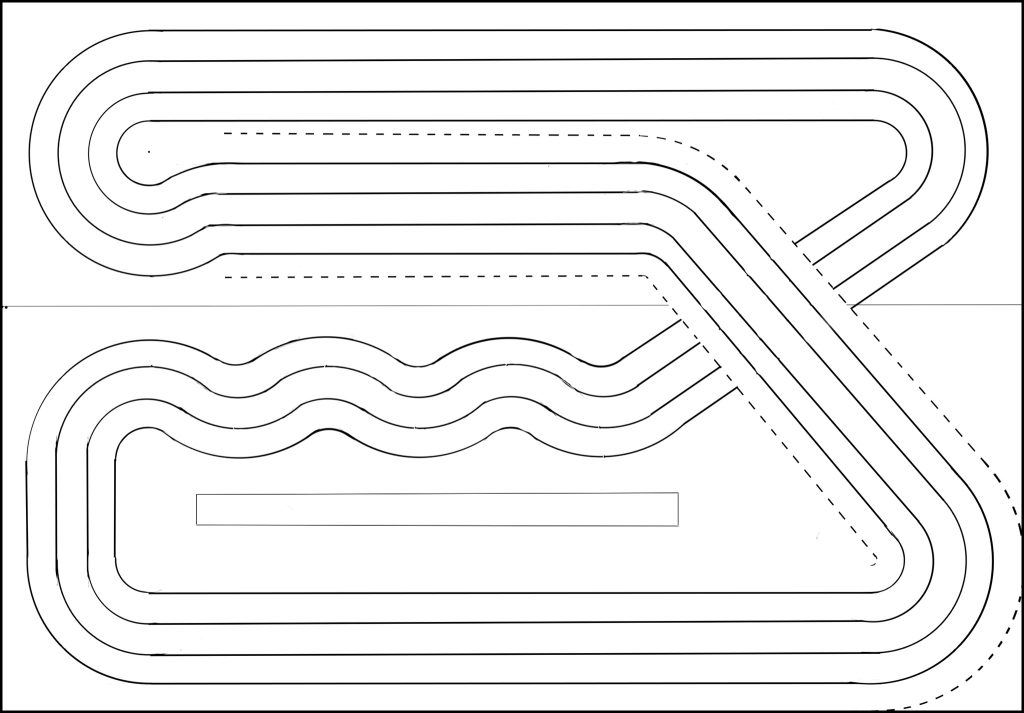
Sometime during pre-production, I decided that my 10’ by 7’ track would be too big for the new room, so we moved our twin beds into the new room, leaving our 12’ by 14’ bedroom for the track. Needless to say, the track dominated the previous bedroom. My father had a carpenter build the base, with two by four legs and a 1” by 6” skirt and cross braces. I did everything else by myself. I bought two sheets of ¾” plywood ten feet long, cut the raised overpass with a jig saw and borrowed a router for the slots. This was the first time I had used power tools and the first time I worked with wood. I painted the track and wired it, using aluminum tape because it was cheaper. I had power connections at two places on the track so power flow would be equalized. I built open-front garages, Sebring style, along the front straight, although these pits were never finished. I mostly had hard plastic slot kits or ready-to-runs in 1/32 scale. This was before the “Thingies” and even before vacuum bodies became popular. I had Revell, Monogram, and Strombecker cars, and built all three Cox Chaparrals. The track had a 42 foot length in each of its 4 lanes. This is about the same length of routed slots as the King’s track. The two photographs below are the only photos of the track.


Unfortunately, as it turned out, my 4-lane design was a little too busy and tight. None of my friends were into slot cars and I can only remember a couple of occasions where we had a four lane race. My brother was only slightly interested and the two of us only had the occasional race. Eighty to ninety percent of the time, I “raced” solo. I would have been much better served with a two or three lane track that flowed better. My track time was like a Zen exercise that I found very soothing, lap after lap, and hour after hour.
There were no commercial tracks nearby. I only made two trips to a commercial track in the Sixties, one to the track in Capital Plaza on a vacation to Austin, and once to a track in California. Both times I only had a couple of my cars with me; they were totally unsuited to racing on a big track. In the Seventies and Eighties, I visited the big track in the Austin area, once when it was at Payton Gin and Ohlen Road and once when it was in Round Rock, both times just to look, never to drive.
My home slot racing ended when I went off to college in 1966 and my priorities shifted. During the time I was away, my parents moved, and I told them that I was not interested in my slot track and what was probably 200 built scale models. I kept only my model contest winners, only one of which I still have, and my Chaparrals.
In the early Seventies, I built a 4-lane T-Jet set on a sheet of plywood. Later I gave this track and about 30 cars to my nephew. In recent years I got this track back, but not the cars. It is stored against the ceiling of my garage.
The only Sixties slot cars that I kept were the three 1/24 Cox Chaparrals. Starting in the Eighties, I began collecting vintage slot cars and track. At that time, prices were reasonable, and cars and tracks were plentiful. One of my main sources was Bob’s Hobby and Collector Shop in Watervliet, Michigan. About once a month or so, he sent out sale lists with hundreds of toys listed. There were trains, and wooden ships, model cars, and, of course, slot cars. This was the Eighties equivalent of the old Auto World catalogs. One had to act quickly in order to acquire the premium stuff. I received the list First Class (of course this was way before the Interweb). If there was something I wanted, I called right away to order it. Sometimes I was lucky; sometimes I was not. I remember buying several Revell 1/32 Ferrari GTO body kits for $1.50 each and he wrote on the order that he had cases of them.
Another resource was Greg Holland’s Vintage Slot Racing Newsletter. This was a monthly newsletter for us hard-core slot fans. I don’t know what the circulation was but it couldn’t have been much, maybe a couple of hundred subscribers, but included collectors from Japan to Europe. There were fan-written articles on manufacturers, specific cars, hobby shops, and home track building. I wrote a couple of articles myself. And, of course, there were sale lists and want ads. I bought, sold, and traded with collectors from everywhere, all, of course, in pre-internet days.
Then there were always the local Goodwills, in the days before gentrification. I must have bought 50 race sets over the years, split between the HO stuff and 1/32 and 1/24, always to get the cars.
I built a Tyco track for our son by mounting the track to ½” plywood and filling in the area around the track with ¼” Masonite, with landscaping flocking sprinkled on wet paint. On the bottom side of the plywood, I glued ¼” cork. The track was hinged to the wall above my son’s bed; when it was folded against the wall, it was a bulletin board, but could be easily laid down onto the bed. This track is currently located at King’s.
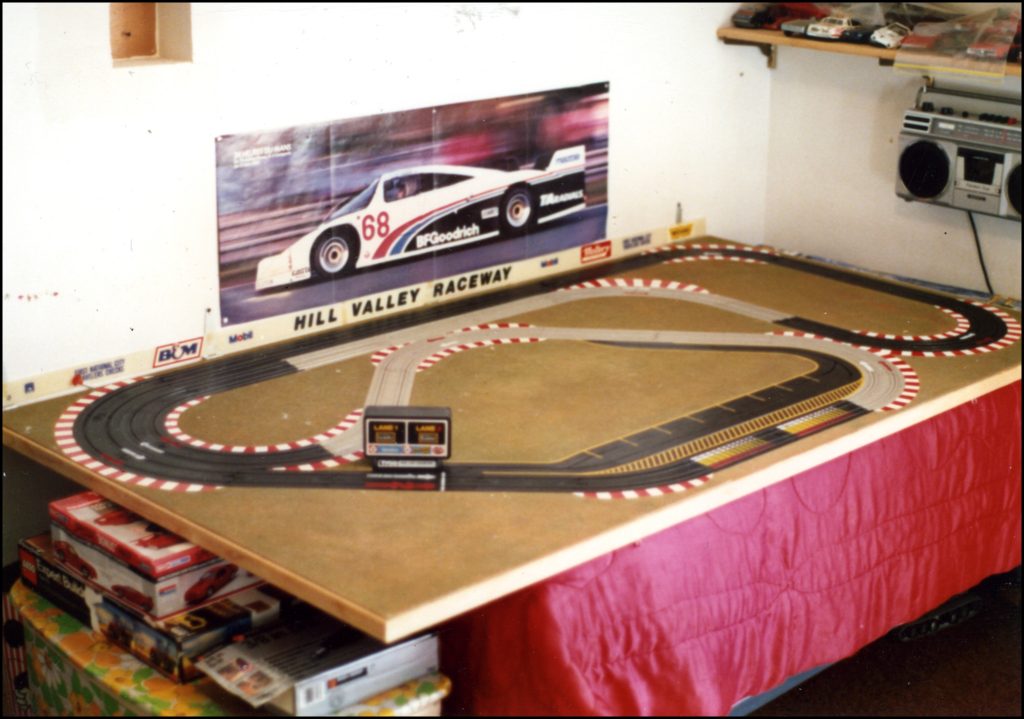

With the approval of a more than understanding wife, I built a 1/32 scale track over our bed. I had a wall mirror with a 2 by 6 frame and Mylar film stretched over a separate 1 X 2 interior frame mounted inside the 2 X 6 and flush with the edge of the 2 by 6. This was all left over from an infinity mirror project in earlier days. This track would also be hinged to the wall. With a plywood base attached to the inside/top edge of the 1 by 2 frame it gave a depth of almost 4 inches to work with. I added wings that stuck out from each end that would be flat against the wall when the track was folded up. It is a little hard to tell in the photograph, but you can see the dark stained border of the 2 by 6 frame. I originally used Strombecker track, later changed to Revell track, again with ¼” painted Masonite to butt up against the plastic track. When the track was folded up, it looked mostly like a thick wall mirror; I had painted the underside of the wings the wall color. The qualities of the photos are not the greatest, but they are the only ones I have.
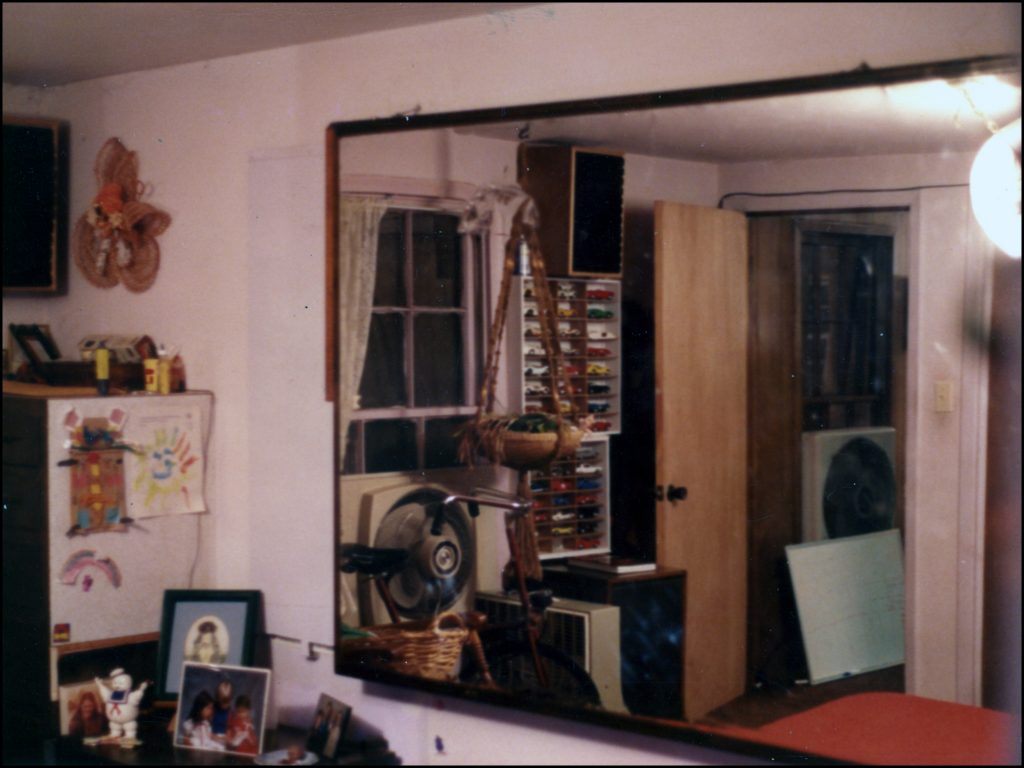

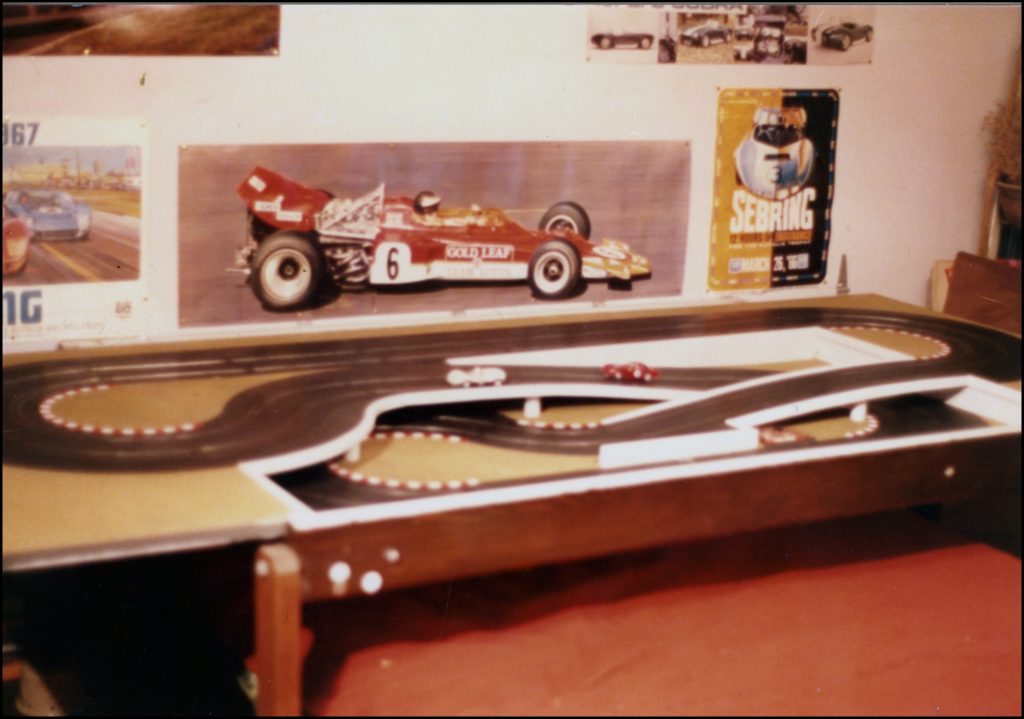
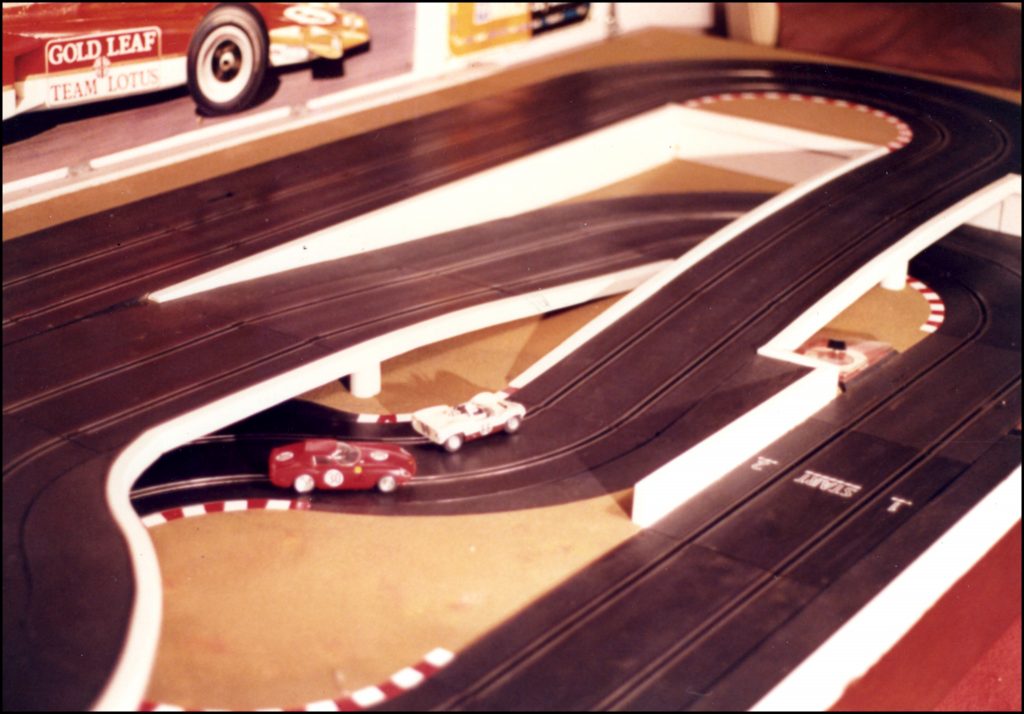
This track also still exists. I moved it to my hobby room where it was usable for a while. Later the track became buried under more shelves and kits and scanners and a large printer. The left end wing now serves as my computer/work desk. Part of the track is still visible below the monitor.


Then, in the Nineties I started buying new slot cars, especially those from Fly. Since the Revell track was now buried, I decided to build a wooden track. I wanted the track to be easily store-able and transportable and I started with a sheet of ¾’ plywood 4’ by 10’. Once the track was routed, I turned it over to work on the bottom. Except for the area that contained the width of the actual track surface, I routed out the rest of the bottom of the plywood, leaving just a little over ¼” in thickness. I did this to make the track as light as possible.


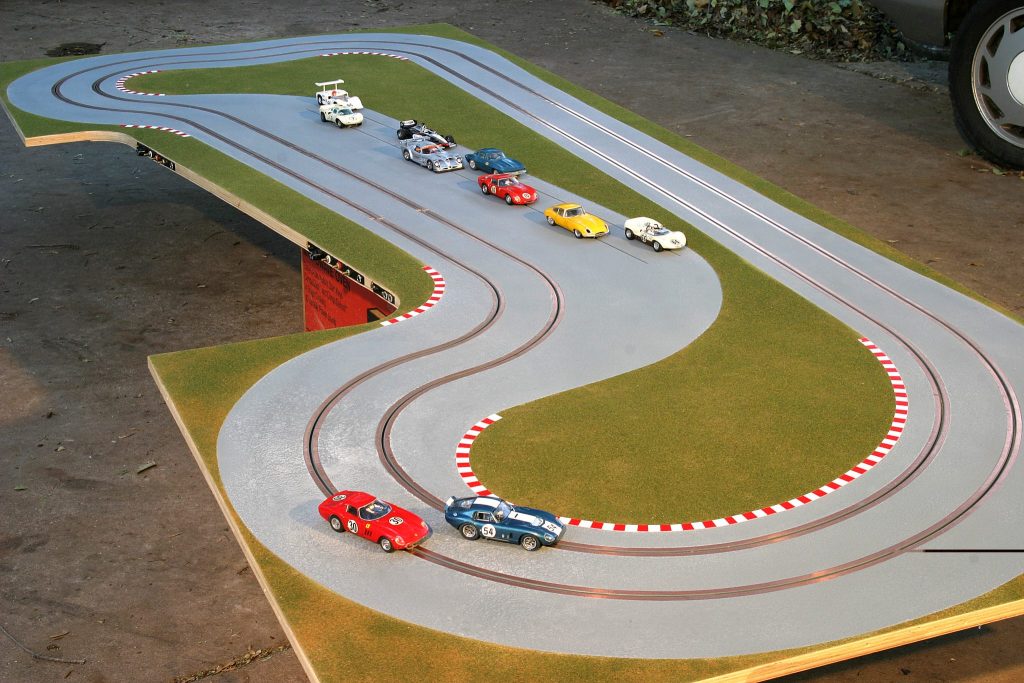
Also, so there would be no obstructions or wiring hanging down underneath, I made the power, controller, switches, and wiring within the ¾’ thickness of the plywood.
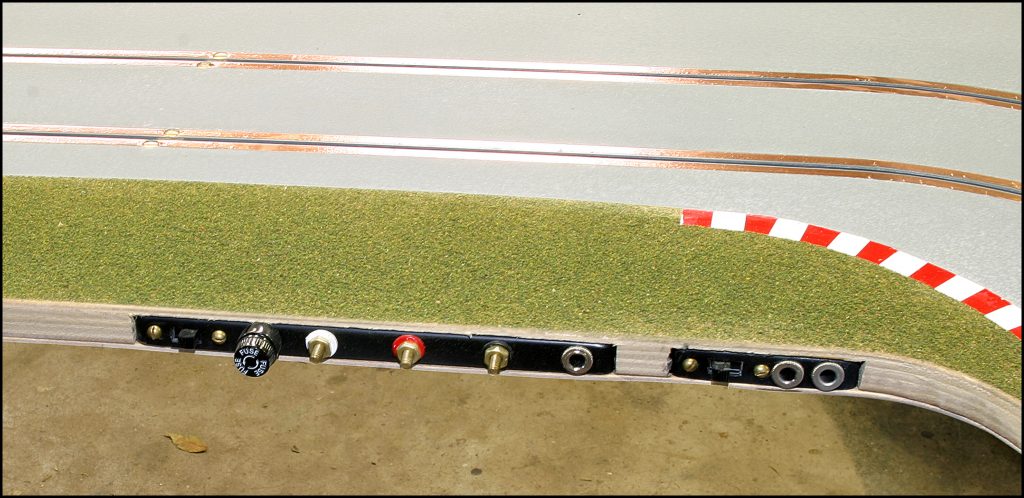
Once this work was completed, I put a sheet of lightweight 1/8” Luan plywood on the bottom. In order to provide a grippy track surface, I sprinkled some fine blasting sand in the fresh track paint. This produced an extremely grippy surface for all types of tires, but is not useful for any tuning work on a car intended to run at King’s. I have not used this track in some time. I may, at some time, refinish the track surface so it will be more comparable to the King’s track.
Which brings me to the latest slot track that I have worked upon: the club track at King’s. This time it was not a solo project but was a cooperative effort that resulted on the great track that we race on today.
What had been a closeted hobby now became a shared experience. This track became a joint project for Marty, Shawn, Brian, Ary and me. I was mostly a hired hand on this project.


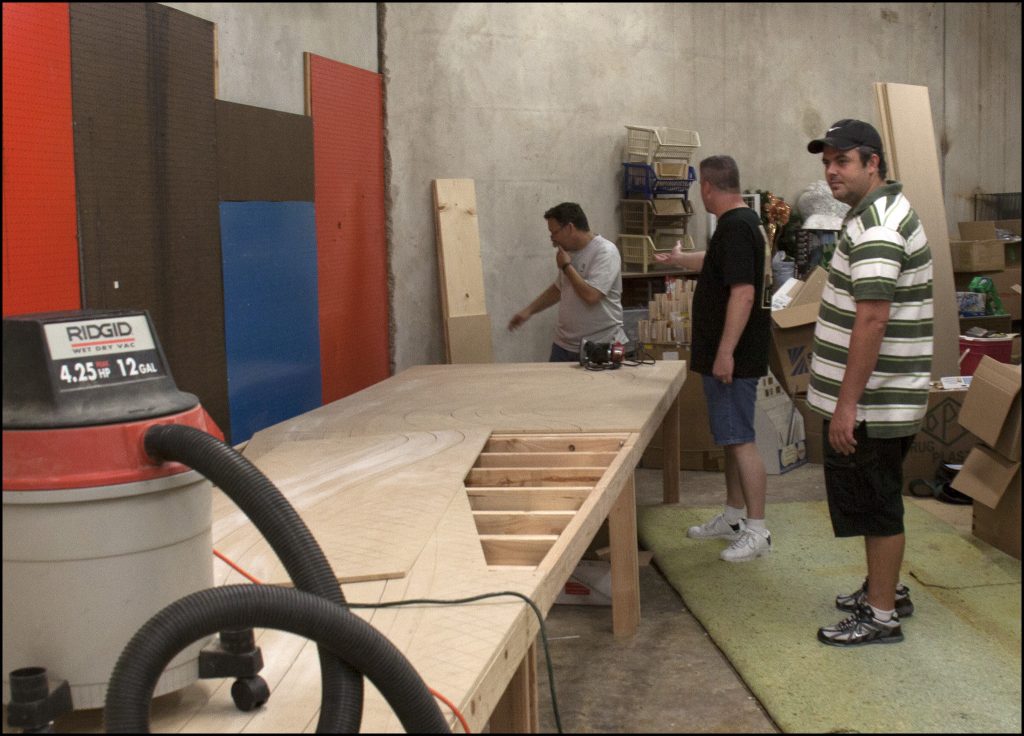




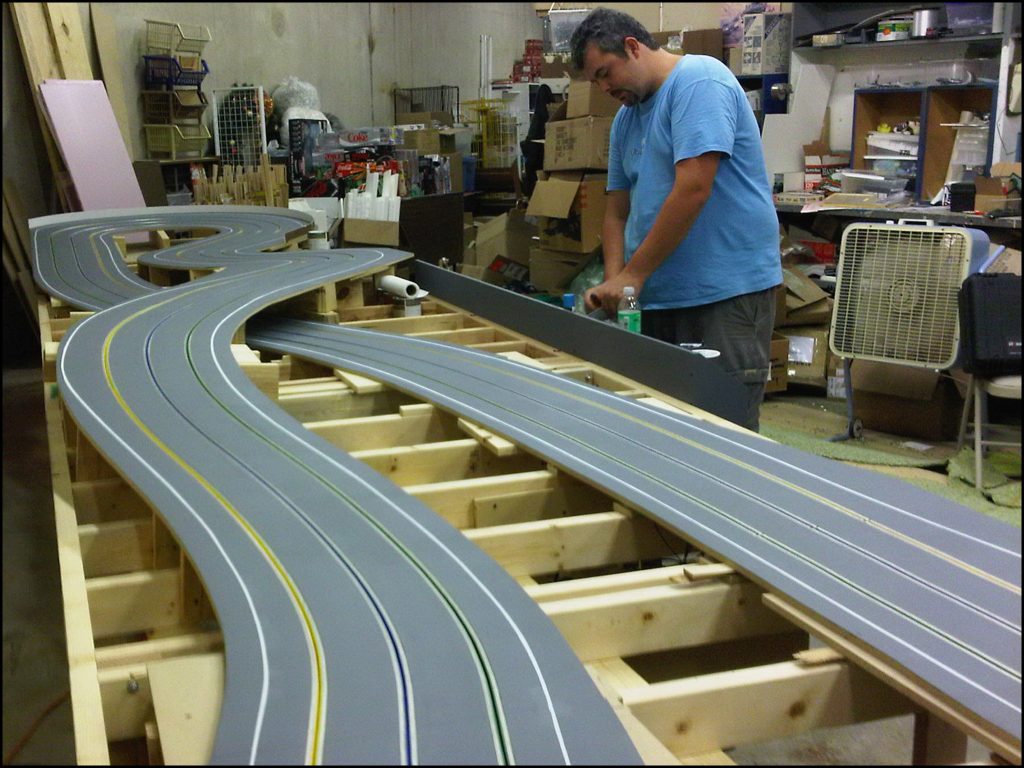
While our mutual interests in cars and racing (large and small scale) initially brought us together, it was the fun and camaraderie that we have when we are together has been what has kept us going. We just enjoy each other’s company, which makes the hobby that much more fun.

This article is more of the AMAZING character that you are
I am so happy to be able to learn just by listening and reading you
I really appreciate this story because it resonates with many of my thoughts
THANKS A LOT, RUSS
An amazing journey, Russell! Thanks for sharing this.
What a great story, Russell! I want to know who THAT Shawn is. I vaguely remember him.
Russell – What an honor it is to be part of your fantastic journey. You are truly an amazing individual and one of the key members of our club. Can’t wait to read the next chapter.
Russell – ditto on all previous comments – WOW, we all *knew you were dedicated and talented but this brings even more of your skills and background to light! It’s to our club’s benefit that your hobby ‘came out of the closet’ and you included us in your journey. I am dying to read background stories from other club members!
Many thanks to everyone’s kind words.